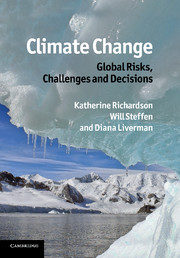Book contents
- Frontmatter
- Contents
- Writing team
- Foreword
- Preface
- List of acronyms and abbreviations
- Part I Climatic trends
- Part II Defining ‘dangerous climate change’
- 5 The impact of climate change on human societies
- 6 Impacts of climate change on the biotic fabric of the planet
- 7 Tipping elements: jokers in the pack
- 8 Linking science and action: targets, timetables and emission budgets
- Part III Equity issues
- Part IV Mitigation and adaptation approaches
- Part V Meeting the challenge
- Index
- Plate section
- References
8 - Linking science and action: targets, timetables and emission budgets
Published online by Cambridge University Press: 04 April 2011
- Frontmatter
- Contents
- Writing team
- Foreword
- Preface
- List of acronyms and abbreviations
- Part I Climatic trends
- Part II Defining ‘dangerous climate change’
- 5 The impact of climate change on human societies
- 6 Impacts of climate change on the biotic fabric of the planet
- 7 Tipping elements: jokers in the pack
- 8 Linking science and action: targets, timetables and emission budgets
- Part III Equity issues
- Part IV Mitigation and adaptation approaches
- Part V Meeting the challenge
- Index
- Plate section
- References
Summary
‘There are times in the history of humanity when fateful decisions are made. The decision … on whether to enter a comprehensive global agreement for strong action on climate change is one of them. …On a balance of probabilities, the failure of our generation would lead to consequences that would haunt humanity until the end of time.’
Political leaders of 194 countries (as of January 2010) have signed the United Nations Framework Convention on Climate Change (UNFCCC), which states in Article 2 that the Convention's ‘ultimate objective … is to achieve… stabilization of greenhouse gas concentrations in the atmosphere at a level that would prevent dangerous anthropogenic interference with the climate system …’. As we have seen in the preceding chapters, scientists are able to document with a very high degree of certainty that human activities exert measurable influence on several components of the climate system. In addition, most scientists agree that, on the basis of observed changes in the climate system, there is a very high probability (>90% according to the IPCC) that these changes are primarily the result of anthropogenic influences on the climate system. Furthermore, many impacts on human societies and nature have already been recorded (Chapters 5 and 6). These impacts can only be expected to increase in the future.
With Article 2 of the UNFCCC as the point of departure, the next step is to determine what actually constitutes ‘dangerous anthropogenic interference with the climate system’, or ‘dangerous climate change’ as it is often called in shorthand.
- Type
- Chapter
- Information
- Climate Change: Global Risks, Challenges and Decisions , pp. 202 - 226Publisher: Cambridge University PressPrint publication year: 2011



